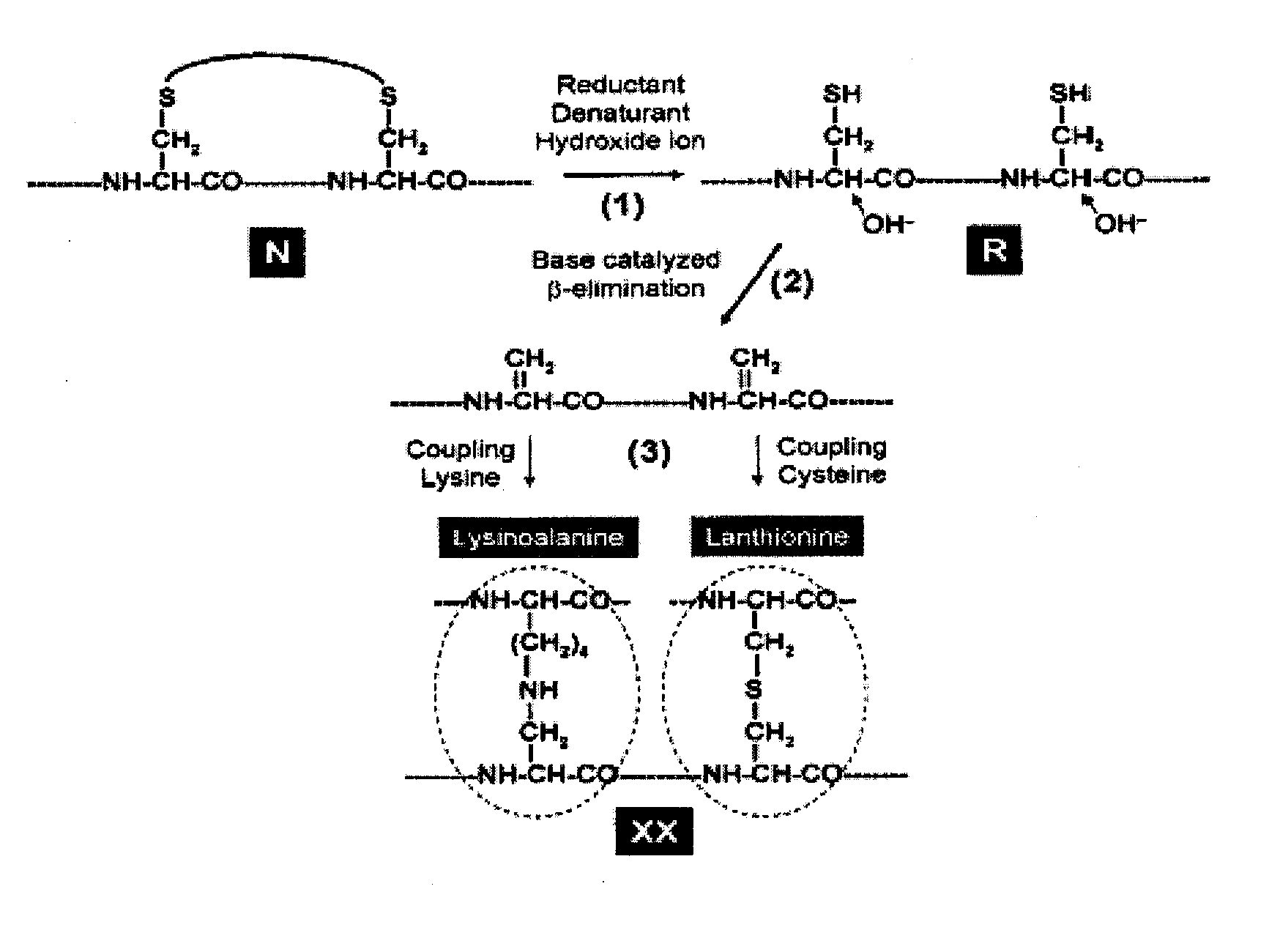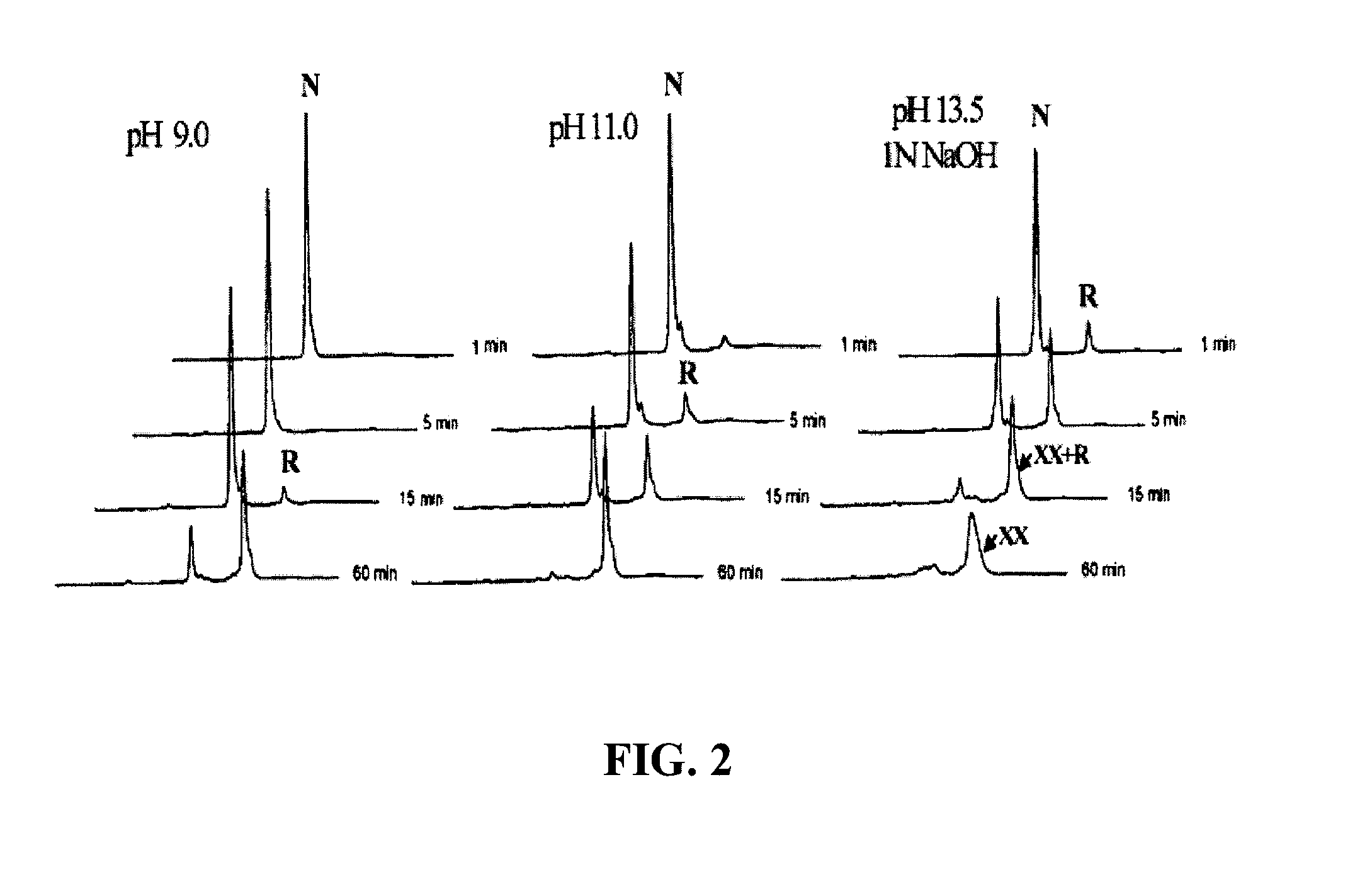Methods and compositions for rapid inactivation of proteins
a technology of inactivation and protein, applied in the fields of protein chemistry, toxins, prions, etc., can solve the problem of permanent inactivation of toxic disulfide proteins, and achieve the effect of rapid cleavage of disulfide bonds, and rapid inactivation of proteins
- Summary
- Abstract
- Description
- Claims
- Application Information
AI Technical Summary
Benefits of technology
Problems solved by technology
Method used
Image
Examples
example 1
High pH and High Concentration of Hydroxide Ion Accelerate the Reduction of Disulfide Bonds and Trigger Covalent Destruction of Sulfydryl Groups
[0115]Reduction of protein disulfide bonds by a reducing agent (such as β-mercaptoethanol, dithiothreitol or tris-carboxyethyl-phosphine) is typically performed at pH 8.0-8.5. The increase of pH can significantly accelerate the reduction of disulfide bonds of native proteins. Hirudin (a 3-disulfide protein) is used as an example here. Native hirudin was incubated with 20 mM, 50 mM or 100 mM of DTT at 22° C. in solutions of pH 9.0, 11.0 and 13.5 respectively. The reactions were quenched at different time points with 10 volumes of 4% aqueous trifuoroacetic acid and analyzed by HPLC (FIG. 2). The three disulfide bonds of native hirudin (N) were reduced collectively, leading to the direct formation of fully reduced hirudin (R) without accumulation of partially reduced intermediate FIG. 2. The rate constants of hirudin reduction were shown to be ...
example 2
The Inclusion of Denaturant Further Accelerates the Reduction and Destruction of Disulfide Bonds
[0117]Denaturant is known to destabilize the conformation of native protein and decrease the covalent stability of disulfide bonds against reduction. In addition to the optimized pH (13.5) for hirudin reduction described above, denaturant (GdnCl and GdnSCN) was included to further accelerate the rate of reduction. Native hirudin (N) was incubated at 22° C. in solutions comprising 1N NaOH, 50 mM DTT and increasing concentrations of GdnCl (0.2M-2M) or GdnSCN (0.1M-I M). The reactions were quenched at different time points with 10 volumes of 4% aqueous trifuoroacetic acid and analyzed by HPLC. The results (FIG. 3) show that inclusion of 0.2M and 0.5M of GdnSCN further accelerates the reduction of hirudin by 2.5-fold and 5-fold respectively. In the presence of 1M of GdnSCN, the reduction of hirudin completes within one minute. The potency of GdnCl is approximately 50% of that of GdnSCN.
[0118]...
example 3
Analysis of the Reversibility of Inactivated Proteins
[0119]Fully reduced and denatured proteins (R) are known to be universally inactivated. However, they are still capable of structural renaturation and restoring their biological activity via oxidative folding. At the stage when free cysteines of R-protein undergo base catalyzed β-elimination, they can be pronounced as irreversibly inactivated. Once cysteines are covalently ravaged (even if only fraction of them), the protein is no longer able to refold and renature. Thus, it is essential to establish a method to measure the reversibility of inactivated protein. This is achieved by: (1) removing the inactivated protein from the denaturant, reductant and hydroxide ion by gel filtration; (2) reconstituting the inactivated protein in a Tris-HCl buffer (0.1M, pH 8.4) containing GSH / GSSG (1 mM / 0.5 mM); (3) incubating the inactivated protein at 22° C. overnight, followed by sample analysis using HPLC or activity based assay. If the inact...
PUM
| Property | Measurement | Unit |
|---|---|---|
| pH | aaaaa | aaaaa |
| temperature | aaaaa | aaaaa |
| size | aaaaa | aaaaa |
Abstract
Description
Claims
Application Information
 Login to View More
Login to View More - R&D
- Intellectual Property
- Life Sciences
- Materials
- Tech Scout
- Unparalleled Data Quality
- Higher Quality Content
- 60% Fewer Hallucinations
Browse by: Latest US Patents, China's latest patents, Technical Efficacy Thesaurus, Application Domain, Technology Topic, Popular Technical Reports.
© 2025 PatSnap. All rights reserved.Legal|Privacy policy|Modern Slavery Act Transparency Statement|Sitemap|About US| Contact US: help@patsnap.com



